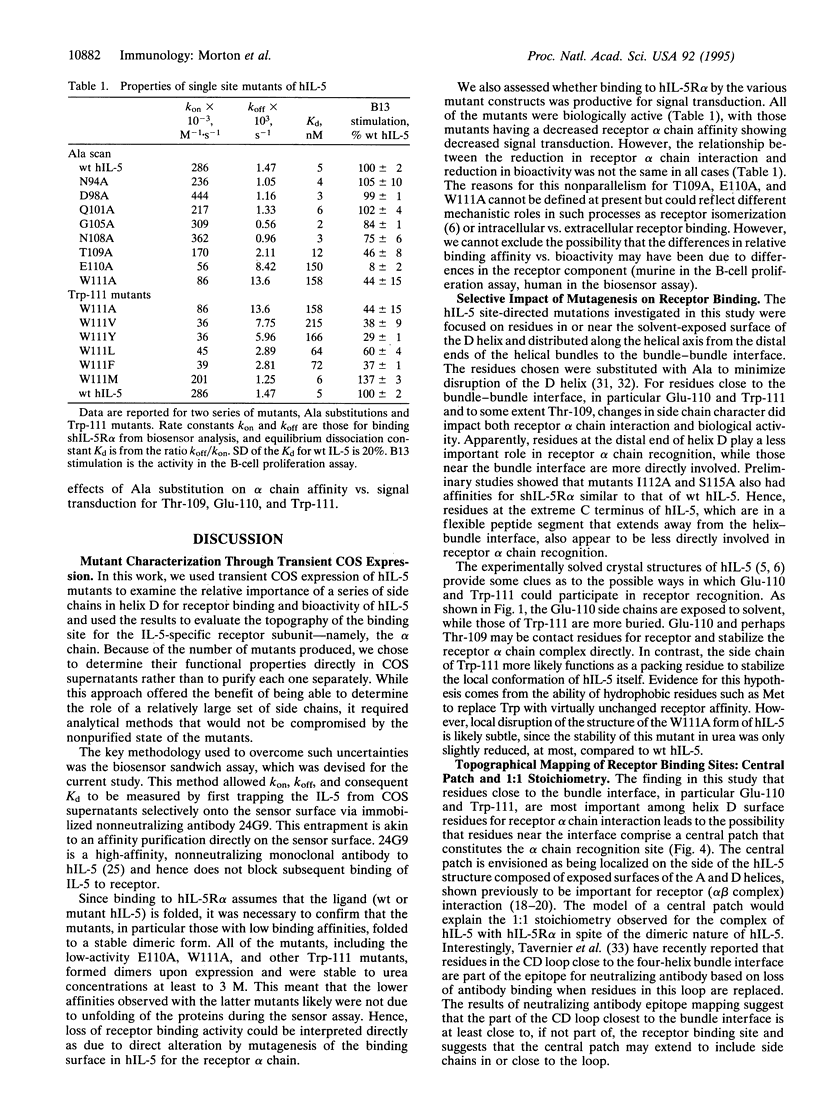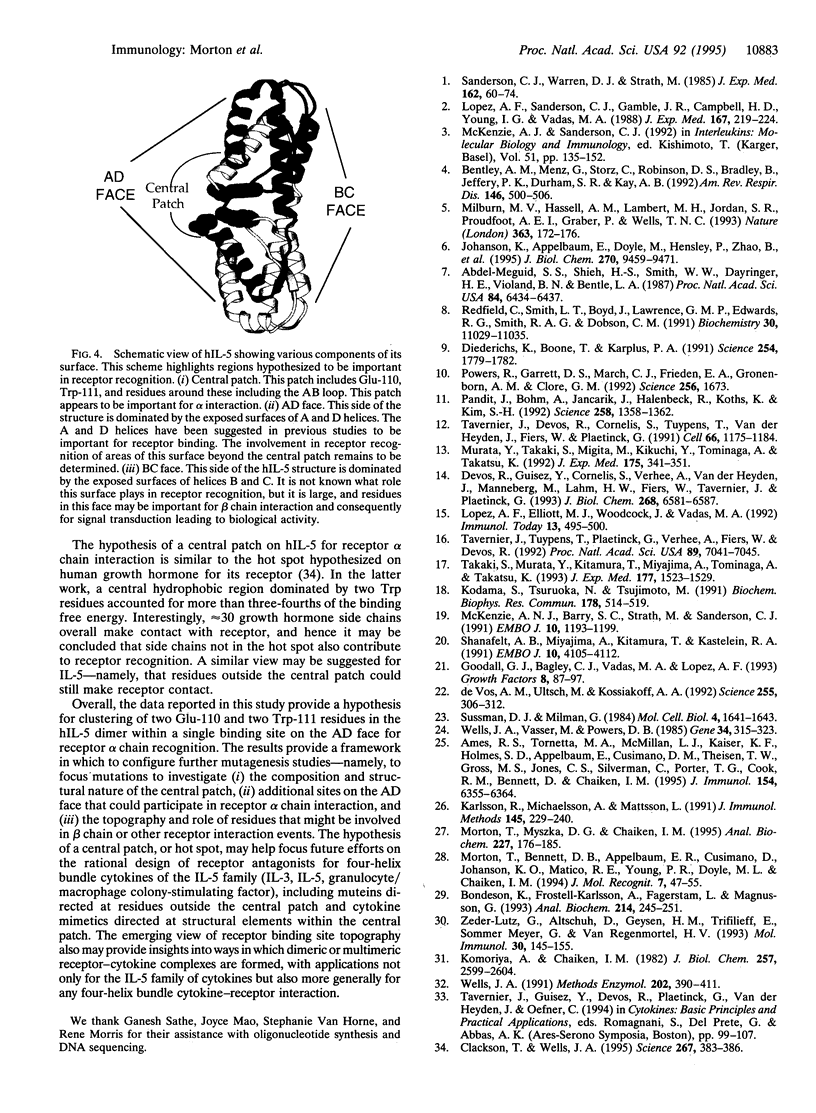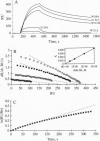Abstract
Cassette mutagenesis was used to identify side chains in human interleukin 5 (hIL-5) that mediate binding to hIL-5 receptor alpha chain (hIL-5R alpha). A series of single alanine substitutions was introduced into a stretch of residues in the C-terminal region, including helix D, which previously had been implicated in receptor alpha chain recognition and which is aligned on the IL-5 surface so as to allow the topography of receptor binding residues to be examined. hIL-5 and single site mutants were expressed in COS cells, their interactions with hIL-5R alpha were measured by a sandwich surface plasmon resonance biosensor method, and their biological activities were measured by an IL-5-dependent cell proliferation assay. A pattern of mutagenesis effects was observed, with greatest impact near the interface between the two four-helix bundles of IL-5, in particular at residues Glu-110 and Trp-111, and least at the distal ends of the D helices. This pattern suggests the possibility that residues near the interface of the two four-helix bundles in hIL-5 comprise a central patch or hot spot, which constitutes an energetically important alpha chain recognition site. This hypothesis suggests a structural explanation for the 1:1 stoichiometry observed for the complex of hIL-5 with hIL-5R alpha.
Full text
PDF




Images in this article
Selected References
These references are in PubMed. This may not be the complete list of references from this article.
- Abdel-Meguid S. S., Shieh H. S., Smith W. W., Dayringer H. E., Violand B. N., Bentle L. A. Three-dimensional structure of a genetically engineered variant of porcine growth hormone. Proc Natl Acad Sci U S A. 1987 Sep;84(18):6434–6437. doi: 10.1073/pnas.84.18.6434. [DOI] [PMC free article] [PubMed] [Google Scholar]
- Ames R. S., Tornetta M. A., McMillan L. J., Kaiser K. F., Holmes S. D., Appelbaum E., Cusimano D. M., Theisen T. W., Gross M. S., Jones C. S. Neutralizing murine monoclonal antibodies to human IL-5 isolated from hybridomas and a filamentous phage Fab display library. J Immunol. 1995 Jun 15;154(12):6355–6364. [PubMed] [Google Scholar]
- Bentley A. M., Menz G., Storz C., Robinson D. S., Bradley B., Jeffery P. K., Durham S. R., Kay A. B. Identification of T lymphocytes, macrophages, and activated eosinophils in the bronchial mucosa in intrinsic asthma. Relationship to symptoms and bronchial responsiveness. Am Rev Respir Dis. 1992 Aug;146(2):500–506. doi: 10.1164/ajrccm/146.2.500. [DOI] [PubMed] [Google Scholar]
- Bondeson K., Frostell-Karlsson A., Fägerstam L., Magnusson G. Lactose repressor-operator DNA interactions: kinetic analysis by a surface plasmon resonance biosensor. Anal Biochem. 1993 Oct;214(1):245–251. doi: 10.1006/abio.1993.1484. [DOI] [PubMed] [Google Scholar]
- Clackson T., Wells J. A. A hot spot of binding energy in a hormone-receptor interface. Science. 1995 Jan 20;267(5196):383–386. doi: 10.1126/science.7529940. [DOI] [PubMed] [Google Scholar]
- Devos R., Guisez Y., Cornelis S., Verhee A., Van der Heyden J., Manneberg M., Lahm H. W., Fiers W., Tavernier J., Plaetinck G. Recombinant soluble human interleukin-5 (hIL-5) receptor molecules. Cross-linking and stoichiometry of binding to IL-5. J Biol Chem. 1993 Mar 25;268(9):6581–6587. [PubMed] [Google Scholar]
- Diederichs K., Boone T., Karplus P. A. Novel fold and putative receptor binding site of granulocyte-macrophage colony-stimulating factor. Science. 1991 Dec 20;254(5039):1779–1782. doi: 10.1126/science.1837174. [DOI] [PubMed] [Google Scholar]
- Goodall G. J., Bagley C. J., Vadas M. A., Lopez A. F. A model for the interaction of the GM-CSF, IL-3 and IL-5 receptors with their ligands. Growth Factors. 1993;8(2):87–97. doi: 10.3109/08977199309046929. [DOI] [PubMed] [Google Scholar]
- Johanson K., Appelbaum E., Doyle M., Hensley P., Zhao B., Abdel-Meguid S. S., Young P., Cook R., Carr S., Matico R. Binding interactions of human interleukin 5 with its receptor alpha subunit. Large scale production, structural, and functional studies of Drosophila-expressed recombinant proteins. J Biol Chem. 1995 Apr 21;270(16):9459–9471. doi: 10.1074/jbc.270.16.9459. [DOI] [PubMed] [Google Scholar]
- Karlsson R., Michaelsson A., Mattsson L. Kinetic analysis of monoclonal antibody-antigen interactions with a new biosensor based analytical system. J Immunol Methods. 1991 Dec 15;145(1-2):229–240. doi: 10.1016/0022-1759(91)90331-9. [DOI] [PubMed] [Google Scholar]
- Kodama S., Tsuruoka N., Tsujimoto M. Role of the C-terminus in the biological activity of human interleukin 5. Biochem Biophys Res Commun. 1991 Jul 31;178(2):514–519. doi: 10.1016/0006-291x(91)90137-v. [DOI] [PubMed] [Google Scholar]
- Komoriya A., Chaiken I. M. Sequence modeling using semisynthetic ribonuclease S. J Biol Chem. 1982 Mar 10;257(5):2599–2604. [PubMed] [Google Scholar]
- Lopez A. F., Elliott M. J., Woodcock J., Vadas M. A. GM-CSF, IL-3 and IL-5: cross-competition on human haemopoietic cells. Immunol Today. 1992 Dec;13(12):495–500. doi: 10.1016/0167-5699(92)90025-3. [DOI] [PubMed] [Google Scholar]
- Lopez A. F., Sanderson C. J., Gamble J. R., Campbell H. D., Young I. G., Vadas M. A. Recombinant human interleukin 5 is a selective activator of human eosinophil function. J Exp Med. 1988 Jan 1;167(1):219–224. doi: 10.1084/jem.167.1.219. [DOI] [PMC free article] [PubMed] [Google Scholar]
- McKenzie A. N., Barry S. C., Strath M., Sanderson C. J. Structure-function analysis of interleukin-5 utilizing mouse/human chimeric molecules. EMBO J. 1991 May;10(5):1193–1199. doi: 10.1002/j.1460-2075.1991.tb08060.x. [DOI] [PMC free article] [PubMed] [Google Scholar]
- Milburn M. V., Hassell A. M., Lambert M. H., Jordan S. R., Proudfoot A. E., Graber P., Wells T. N. A novel dimer configuration revealed by the crystal structure at 2.4 A resolution of human interleukin-5. Nature. 1993 May 13;363(6425):172–176. doi: 10.1038/363172a0. [DOI] [PubMed] [Google Scholar]
- Morton T. A., Bennett D. B., Appelbaum E. R., Cusimano D. M., Johanson K. O., Matico R. E., Young P. R., Doyle M., Chaiken I. M. Analysis of the interaction between human interleukin-5 and the soluble domain of its receptor using a surface plasmon resonance biosensor. J Mol Recognit. 1994 Mar;7(1):47–55. doi: 10.1002/jmr.300070107. [DOI] [PubMed] [Google Scholar]
- Morton T. A., Myszka D. G., Chaiken I. M. Interpreting complex binding kinetics from optical biosensors: a comparison of analysis by linearization, the integrated rate equation, and numerical integration. Anal Biochem. 1995 May 1;227(1):176–185. doi: 10.1006/abio.1995.1268. [DOI] [PubMed] [Google Scholar]
- Murata Y., Takaki S., Migita M., Kikuchi Y., Tominaga A., Takatsu K. Molecular cloning and expression of the human interleukin 5 receptor. J Exp Med. 1992 Feb 1;175(2):341–351. doi: 10.1084/jem.175.2.341. [DOI] [PMC free article] [PubMed] [Google Scholar]
- Pandit J., Bohm A., Jancarik J., Halenbeck R., Koths K., Kim S. H. Three-dimensional structure of dimeric human recombinant macrophage colony-stimulating factor. Science. 1992 Nov 20;258(5086):1358–1362. doi: 10.1126/science.1455231. [DOI] [PubMed] [Google Scholar]
- Powers R., Garrett D. S., March C. J., Frieden E. A., Gronenborn A. M., Clore G. M. Three-dimensional solution structure of human interleukin-4 by multidimensional heteronuclear magnetic resonance spectroscopy. Science. 1992 Jun 19;256(5064):1673–1677. doi: 10.1126/science.256.5064.1673. [DOI] [PubMed] [Google Scholar]
- Redfield C., Smith L. J., Boyd J., Lawrence G. M., Edwards R. G., Smith R. A., Dobson C. M. Secondary structure and topology of human interleukin 4 in solution. Biochemistry. 1991 Nov 19;30(46):11029–11035. doi: 10.1021/bi00110a004. [DOI] [PubMed] [Google Scholar]
- Sanderson C. J., Warren D. J., Strath M. Identification of a lymphokine that stimulates eosinophil differentiation in vitro. Its relationship to interleukin 3, and functional properties of eosinophils produced in cultures. J Exp Med. 1985 Jul 1;162(1):60–74. doi: 10.1084/jem.162.1.60. [DOI] [PMC free article] [PubMed] [Google Scholar]
- Shanafelt A. B., Miyajima A., Kitamura T., Kastelein R. A. The amino-terminal helix of GM-CSF and IL-5 governs high affinity binding to their receptors. EMBO J. 1991 Dec;10(13):4105–4112. doi: 10.1002/j.1460-2075.1991.tb04987.x. [DOI] [PMC free article] [PubMed] [Google Scholar]
- Sussman D. J., Milman G. Short-term, high-efficiency expression of transfected DNA. Mol Cell Biol. 1984 Aug;4(8):1641–1643. doi: 10.1128/mcb.4.8.1641. [DOI] [PMC free article] [PubMed] [Google Scholar]
- Takaki S., Murata Y., Kitamura T., Miyajima A., Tominaga A., Takatsu K. Reconstitution of the functional receptors for murine and human interleukin 5. J Exp Med. 1993 Jun 1;177(6):1523–1529. doi: 10.1084/jem.177.6.1523. [DOI] [PMC free article] [PubMed] [Google Scholar]
- Tavernier J., Devos R., Cornelis S., Tuypens T., Van der Heyden J., Fiers W., Plaetinck G. A human high affinity interleukin-5 receptor (IL5R) is composed of an IL5-specific alpha chain and a beta chain shared with the receptor for GM-CSF. Cell. 1991 Sep 20;66(6):1175–1184. doi: 10.1016/0092-8674(91)90040-6. [DOI] [PubMed] [Google Scholar]
- Tavernier J., Tuypens T., Plaetinck G., Verhee A., Fiers W., Devos R. Molecular basis of the membrane-anchored and two soluble isoforms of the human interleukin 5 receptor alpha subunit. Proc Natl Acad Sci U S A. 1992 Aug 1;89(15):7041–7045. doi: 10.1073/pnas.89.15.7041. [DOI] [PMC free article] [PubMed] [Google Scholar]
- Wells J. A. Systematic mutational analyses of protein-protein interfaces. Methods Enzymol. 1991;202:390–411. doi: 10.1016/0076-6879(91)02020-a. [DOI] [PubMed] [Google Scholar]
- Wells J. A., Vasser M., Powers D. B. Cassette mutagenesis: an efficient method for generation of multiple mutations at defined sites. Gene. 1985;34(2-3):315–323. doi: 10.1016/0378-1119(85)90140-4. [DOI] [PubMed] [Google Scholar]
- Zeder-Lutz G., Altschuh D., Geysen H. M., Trifilieff E., Sommermeyer G., Van Regenmortel M. H. Monoclonal antipeptide antibodies: affinity and kinetic rate constants measured for the peptide and the cognate protein using a biosensor technology. Mol Immunol. 1993 Feb;30(2):145–155. doi: 10.1016/0161-5890(93)90086-q. [DOI] [PubMed] [Google Scholar]
- de Vos A. M., Ultsch M., Kossiakoff A. A. Human growth hormone and extracellular domain of its receptor: crystal structure of the complex. Science. 1992 Jan 17;255(5042):306–312. doi: 10.1126/science.1549776. [DOI] [PubMed] [Google Scholar]






